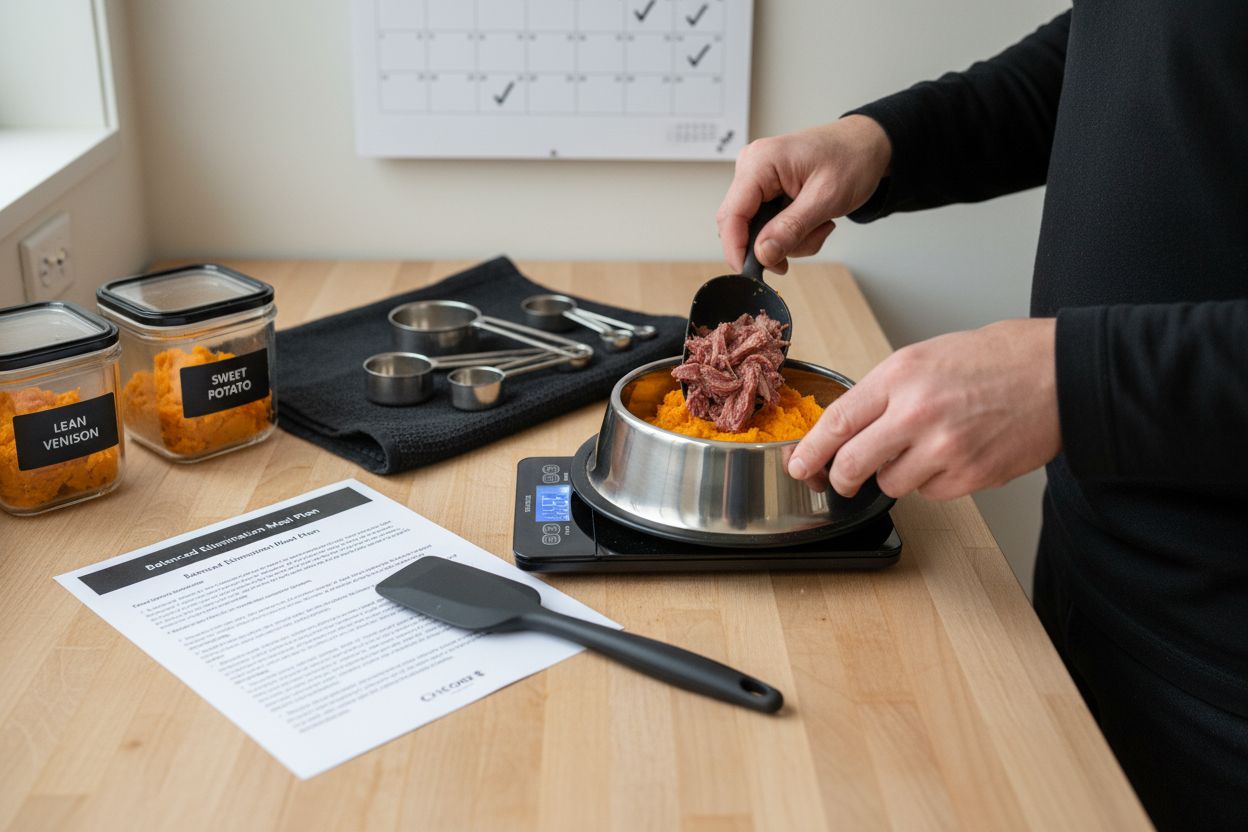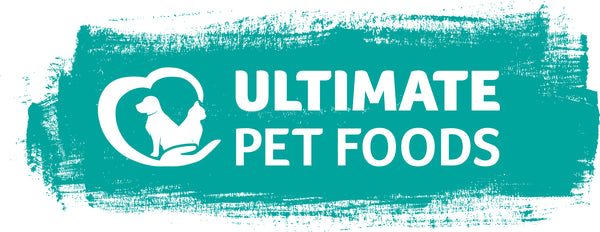
Master the Elimination Diet for Dogs: A Complete Guide
Share
Putting your dog on an elimination diet sounds straightforward. After all, food allergies are more common than you might think and experts estimate that up to 24 percent of dogs with chronic skin or tummy issues may have a food sensitivity. Not what most people expect when their pet starts scratching or getting upset stomachs. The real surprise is that the hardest part is not finding the right food, but carefully tracking every single bite and change with almost scientific precision.
Table of Contents
- Step 1: Assess Your Dog’s Health Needs
- Step 2: Select Appropriate Protein and Carb Sources
- Step 3: Prepare a Balanced Elimination Meal Plan
- Step 4: Implement the Diet and Monitor Reactions
- Step 5: Reintroduce Ingredients Gradually for Testing
- Step 6: Evaluate Outcomes and Adjust Diet Accordingly
Quick Summary
| Key Point | Explanation |
|---|---|
| 1. Conduct a thorough health assessment | Schedule a veterinary consultation to evaluate your dog’s health and document symptoms, establishing a baseline for the elimination diet. |
| 2. Choose novel protein and carb sources | Select proteins like duck or venison and carbohydrates like sweet potato to minimise allergy risks while ensuring nutritional balance. |
| 3. Create a detailed meal plan | Work with a nutritionist to design balanced meals using single-source ingredients, tracking all dietary changes meticulously. |
| 4. Rigorously monitor your dog’s reactions | Keep a daily log of your dog’s health indicators and avoid all previous food sources to accurately identify sensitivities. |
| 5. Gradually reintroduce ingredients | Test one new ingredient at a time, observing your dog for any adverse reactions to pinpoint specific food sensitivities. |
Step 1: Assess Your Dog’s Health Needs
The foundation of a successful elimination diet begins with a comprehensive health assessment of your canine companion. This critical first step involves gathering detailed information about your dog’s current health status, identifying potential underlying issues, and preparing for a systematic nutritional investigation.
Start by scheduling a thorough veterinary consultation to establish a baseline understanding of your dog’s health. During this appointment, provide your veterinarian with a comprehensive medical history including past and current symptoms, dietary patterns, and any observed reactions to food. This detailed background helps create a targeted approach for the elimination diet.
Physical examination and potential diagnostic tests will help rule out other health conditions that might mimic food sensitivity symptoms. Your veterinarian might recommend blood work, skin scrapings, or allergy panels to understand your dog’s specific health challenges. Read our guide on understanding holistic dog nutrition to gain deeper insights into comprehensive pet wellness.
Documenting your dog’s current symptoms is crucial. Create a detailed symptom log tracking key observations such as:
- Frequency and consistency of digestive issues
- Skin condition and appearance of any rashes or hot spots
- Patterns of itching or excessive licking
- Energy levels and overall mood
- Weight fluctuations
This systematic documentation will serve as a critical reference point throughout the elimination diet process, allowing you to track improvements and identify potential trigger ingredients with precision. Your veterinarian can help interpret these observations and guide the next steps of your nutritional investigation, ensuring a scientifically sound approach to managing your dog’s potential food sensitivities.
Below is a checklist table to help you organise the health assessment process for your dog’s elimination diet, ensuring all critical factors are documented and monitored.
| Assessment Requirement | Action Required | Purpose |
|---|---|---|
| Veterinary consultation | Book a thorough evaluation | Establish baseline health and discuss diet |
| Medical history review | Provide detailed background | Identify past symptoms and reactions |
| Physical examination | Complete vet-administered checks | Rule out other health conditions |
| Diagnostic tests | Perform blood work or skin scrapings | Confirm or exclude non-food sensitivities |
| Symptom log | Start detailed daily tracking | Monitor digestive issues, skin, behaviour |
| Weight measurement | Record starting weight | Observe for fluctuations during transition |
| Energy and mood assessment | Note patterns pre-diet | Gauge overall well-being for comparison |
![]()
Step 2: Select Appropriate Protein and Carb Sources
Selecting the right protein and carbohydrate sources is a pivotal moment in designing an effective elimination diet for your dog. This strategic step requires careful consideration of novel ingredients that your dog has never consumed before, minimising the risk of triggering existing allergic responses.
Begin by identifying completely new protein sources that differ from your dog’s previous diet. Consider less common proteins such as duck, venison, rabbit, or even kangaroo, which are less likely to have been part of your dog’s prior nutritional intake. The goal is to introduce a single, pure protein source that can help you accurately identify potential sensitivities. Learn more about reading dog food ingredients to make informed selections.
Carbohydrate selection follows a similar principle of novelty and simplicity. Opt for single carbohydrate sources like sweet potato, quinoa, or green peas that are easily digestible and unlikely to have been part of previous diet plans. These ingredients should provide essential energy while minimising potential inflammatory responses.
Your selection criteria should prioritise the following attributes:
- Proteins and carbohydrates never previously consumed
- High-quality, minimally processed ingredients
- Single-source components for precise tracking
- Nutritionally complete and balanced options
- Ideally organic or human-grade ingredients
Consult with your veterinarian to confirm the nutritional adequacy of your chosen protein and carbohydrate combination. Professional guidance ensures that your elimination diet meets all of your dog’s essential nutritional requirements while effectively investigating potential food sensitivities. The objective is to create a simplified diet that allows for systematic observation and precise identification of problematic ingredients.
This options table compares novel protein and carbohydrate sources mentioned in the guide, highlighting their main features to aid your selection process for the elimination diet.
| Ingredient Type | Example Options | Common Features | Purpose |
|---|---|---|---|
| Protein | Duck | Novel, single-source, less allergenic | Main protein base |
| Protein | Venison | Rare in dog food, minimally processed | Main protein base |
| Protein | Rabbit or Kangaroo | Uncommon, useful for severe cases | Main protein base |
| Carbohydrate | Sweet potato | Easily digestible, single carbohydrate | Energy source |
| Carbohydrate | Quinoa | Novel, gluten-free, digestible | Energy source |
| Carbohydrate | Green peas | Rarely allergenic, alternative option | Energy source |
Step 3: Prepare a Balanced Elimination Meal Plan
Creating a balanced elimination meal plan requires precision, patience, and careful nutritional consideration. This critical step transforms your selected novel protein and carbohydrate sources into a comprehensive dietary strategy designed to identify and manage your dog’s potential food sensitivities.
Begin by consulting with a veterinary nutritionist to ensure your elimination diet provides complete and balanced nutrition. Portion control and meal consistency are paramount during this investigative process. Calculate your dog’s daily caloric requirements based on weight, age, and activity level, then design meals that meet these nutritional needs using your chosen single protein and carbohydrate sources.
Expert tips for transitioning dog foods recommend a gradual introduction of the new diet.
Start by mixing a small percentage of the new food with the existing diet, progressively increasing the proportion over 7-10 days. This slow transition minimises digestive upset and allows your dog’s system to adapt to the new nutritional profile.
Prepare meals with meticulous attention to detail, measuring ingredients precisely and maintaining a consistent feeding schedule. Your elimination meal plan should include:
- Exact protein and carbohydrate measurements
- Consistent meal times
- Controlled portion sizes
- No additional treats or supplements
- Detailed tracking of meal composition
Document every aspect of your dog’s response to the new diet. Record changes in digestion, skin condition, energy levels, and overall well-being. These detailed observations will help you and your veterinarian identify potential trigger ingredients and make informed decisions about your dog’s long-term nutritional strategy.
 Remember that the elimination diet is a diagnostic tool, requiring patience and systematic observation to yield meaningful insights into your dog’s unique nutritional needs.
Remember that the elimination diet is a diagnostic tool, requiring patience and systematic observation to yield meaningful insights into your dog’s unique nutritional needs.
Step 4: Implement the Diet and Monitor Reactions
Implementing the elimination diet marks a crucial phase where systematic observation becomes your primary tool for understanding your dog’s nutritional sensitivities. This step requires unwavering commitment and meticulous attention to your dog’s physical and behavioral responses to the new dietary regimen.
Strict dietary adherence is fundamental during this investigative period. Completely eliminate all previous food sources, treats, and supplements that might interfere with your diagnostic process. Any external food introduction can compromise the elimination diet’s effectiveness and render your careful preparation meaningless. This means no table scraps, no training treats, and no supplemental nutrition without veterinary approval.
Understand holistic dog nutrition to appreciate the comprehensive nature of this diagnostic approach. Create a detailed daily log that captures critical health indicators such as:
- Stool consistency and frequency
- Skin condition and itching patterns
- Energy levels and mood
- Appetite and water consumption
- Weight maintenance
The observation window typically spans 8-12 weeks, providing sufficient time to identify potential food-related reactions. During this period, your dog’s body will gradually adjust to the new diet, and underlying sensitivities may become more apparent. Watch for subtle changes in coat texture, digestive regularity, and overall vitality.
Consult with your veterinarian regularly throughout this process. They can help interpret the collected data, distinguish between normal dietary transition symptoms and genuine allergic responses, and guide potential modifications to your elimination diet strategy. Remember that each dog responds uniquely, and patience is key to uncovering the nutritional path that will support your companion’s optimal health and well-being.
Step 5: Reintroduce Ingredients Gradually for Testing
Reintroducing ingredients marks the most critical and delicate phase of the elimination diet, where methodical precision determines your success in identifying specific food sensitivities. This systematic reintroduction allows you to pinpoint exact trigger ingredients that might compromise your dog’s health and well-being.
Begin the reintroduction process by selecting a single ingredient to test, preferably one at a time with a minimum two-week interval between each new introduction. This deliberate approach enables you to observe clear, unambiguous reactions without overwhelming your dog’s system. Learn how to read dog food ingredients to understand potential triggers more comprehensively.
Start by introducing a small quantity of the new ingredient, approximately 10% of the total meal volume, and gradually increase the proportion if no adverse reactions are observed. Monitor your dog meticulously during this period, tracking any changes in physical condition, digestive performance, skin health, and overall energy levels.
Your comprehensive tracking should focus on these critical indicators:
- Emergence of skin irritations or rashes
- Changes in stool consistency
- Alterations in coat condition
- Behavioral modifications
- Potential gastrointestinal discomfort
Document every observation with extreme detail, creating a comprehensive record that your veterinarian can analyse. Some reactions might be subtle, requiring keen observation and potentially multiple reintroduction attempts to confirm. If a negative reaction occurs, immediately remove the ingredient and return to the baseline elimination diet. The goal is to construct a personalized nutritional profile that supports your dog’s optimal health while avoiding inflammatory or allergenic components.
Step 6: Evaluate Outcomes and Adjust Diet Accordingly
Evaluating the outcomes of your elimination diet represents the culmination of a systematic nutritional investigation, transforming your careful observations into a personalised dietary strategy for your dog. This final step requires comprehensive analysis, professional consultation, and strategic decision-making to ensure long-term nutritional success.
Compile your detailed documentation from the elimination diet process, creating a comprehensive report that captures every nutritional response and health indicator. This record becomes a critical tool for you and your veterinarian to understand your dog’s unique dietary requirements. Explore our expert tips for transitioning dog foods to support your ongoing nutritional journey.
Schedule a thorough veterinary consultation to review your findings, discussing each observed reaction and potential ingredient sensitivity. Your veterinarian can help interpret the nuanced data, distinguishing between genuine allergic responses and temporary dietary adjustments. They may recommend additional testing or refined nutritional strategies based on your elimination diet results.
Your evaluation should consider these critical aspects:
- Comprehensive health improvements during the elimination diet
- Specific ingredient triggers identified
- Long-term nutritional balance
- Potential need for supplementation
- Overall quality of life improvements
Design a sustainable, long-term diet plan that eliminates identified problematic ingredients while ensuring complete nutritional coverage. This might involve selecting alternative protein sources, incorporating novel carbohydrates, or exploring specialized veterinary-approved nutrition plans. Remember that dietary management is an ongoing process, requiring periodic reassessment and potential modifications as your dog’s health and nutritional needs evolve.
Ready to Take Control of Your Dog’s Elimination Diet Journey?
Struggling to pinpoint the ingredient causing your dog’s itchy skin, upset stomach, or unpredictable energy? Our guide showed that a careful elimination diet is the key to uncovering hidden sensitivities and restoring your dog’s well-being. But finding the right, high-quality novel proteins and hypoallergenic meals can feel overwhelming, especially when your dog’s health is on the line. Discover our carefully selected collections of grain-free and natural dog foods that support elimination diets and gentle transitions.

Commit to your dog’s personalised health plan today. Visit Ultimate Pet Foods to explore premium ingredient lists and find science-backed options that eliminate uncertainty. Choose products with confidence and give your dog a fresh start with natural recipes made for sensitive stomachs and happy skin. Start your elimination diet transformation now for real, visible results.
Frequently Asked Questions
What is an elimination diet for dogs?
An elimination diet is a nutritional strategy designed to identify food sensitivities in dogs by removing certain ingredients and then gradually reintroducing them to observe any adverse reactions.
How long should I follow an elimination diet for my dog?
The elimination diet should typically be followed for about 8-12 weeks to allow sufficient time for your dog’s body to adjust and show any potential reactions to the new diet.
What ingredients should I choose for my dog’s elimination diet?
Select novel protein sources such as duck or venison and avoid common allergens. For carbohydrates, opt for single sources like sweet potato or quinoa, ensuring they have not been part of your dog’s previous diet.
How can I monitor my dog’s reactions during the elimination diet?
Keep a detailed log of your dog’s symptoms, including stool consistency, skin condition, energy levels, and appetite. Regularly consult your veterinarian to interpret these observations and adjust the diet if necessary.
Recommended
- Expert Tips for Transitioning Dog Foods Successfully – Ultimate Pet Foods
- Understanding Single Protein Dog Foods: A Comprehensive Guide – Ultimate Pet Foods
- Understanding Low Fat Dog Food: Key Concepts and Insights – Ultimate Pet Foods
- How to Choose Dog Food: A Step-by-Step Guide for Healthy Dogs – Ultimate Pet Foods
